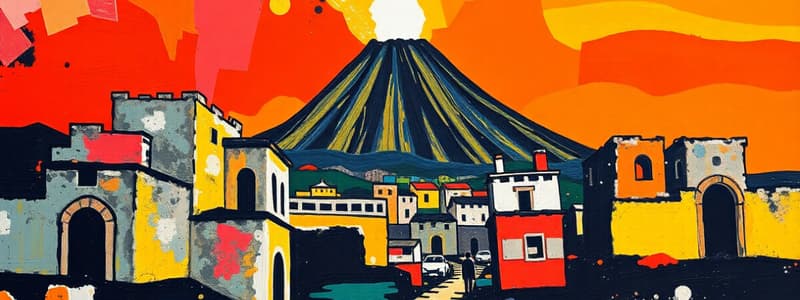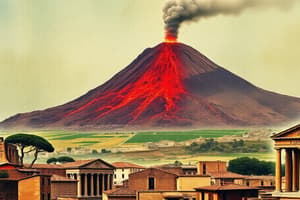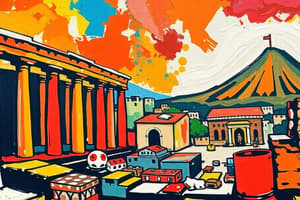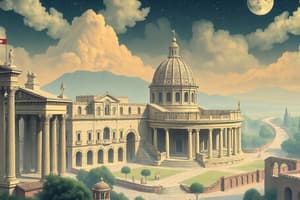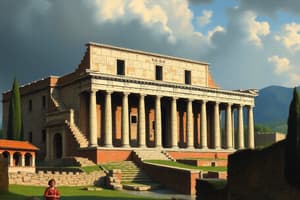Podcast
Questions and Answers
What does the presence of carbonized trees swept into a corner by the eruption most directly indicate about the immediate aftermath of the volcanic event?
What does the presence of carbonized trees swept into a corner by the eruption most directly indicate about the immediate aftermath of the volcanic event?
- The force of the eruption was powerful enough to displace and transport large objects significant distances. (correct)
- The eruption caused localized forest fires, which then spread throughout the region.
- The initial pyroclastic flow was followed by a period of heavy rainfall, leading to mudslides.
- Deforestation efforts prior to the eruption contributed to the accumulation of flammable debris.
How do Bourbon-era tunnels contribute to our understanding of Herculaneum's layout and history?
How do Bourbon-era tunnels contribute to our understanding of Herculaneum's layout and history?
- They showcase the initial stages of excavation and the methods used to discover the city. (correct)
- They expose the methods used by ancient Romans for underground construction and infrastructure.
- They provide direct access to residential areas, revealing insights into domestic life.
- They offer an unobstructed view of the original city walls, clarifying the city's defensive structures.
What does the presence of a Hydra-shaped fountain potentially symbolize about the values or beliefs of Herculaneum's inhabitants?
What does the presence of a Hydra-shaped fountain potentially symbolize about the values or beliefs of Herculaneum's inhabitants?
- Residents of Herculaneum likely revered mythological figures and narratives. (correct)
- The fountain served a practical civic function, such as providing drinking water during public gatherings
- The town was well-defended, known for military prowess and strategic alliances with neighboring regions.
- The city prioritized advanced hydraulic engineering and water management systems.
In what way do the well-preserved thermopolia along Cardo V enhance our understanding of daily life in Herculaneum?
In what way do the well-preserved thermopolia along Cardo V enhance our understanding of daily life in Herculaneum?
How does the reconstruction of carbonized wooden beams along the Decumanus Maximus contribute to the visitor experience and scholarly understanding of Herculaneum?
How does the reconstruction of carbonized wooden beams along the Decumanus Maximus contribute to the visitor experience and scholarly understanding of Herculaneum?
How did the eruption of Mount Vesuvius in 79 AD alter Herculaneum's geographical context, and what lasting impact did this have on the city's layout and accessibility?
How did the eruption of Mount Vesuvius in 79 AD alter Herculaneum's geographical context, and what lasting impact did this have on the city's layout and accessibility?
What insight do the remains of the victims found in the boat sheds of Herculaneum provide regarding the health and lifestyle of the city's inhabitants during the 1st century AD?
What insight do the remains of the victims found in the boat sheds of Herculaneum provide regarding the health and lifestyle of the city's inhabitants during the 1st century AD?
How did Marcus Nonius Balbus contribute to the urban development and social fabric of Herculaneum, and what evidence supports this?
How did Marcus Nonius Balbus contribute to the urban development and social fabric of Herculaneum, and what evidence supports this?
How does the House of the Relief of Telephus exemplify the architectural and decorative trends prevalent in Herculaneum during its peak, and what does it suggest about the inhabitants' cultural tastes?
How does the House of the Relief of Telephus exemplify the architectural and decorative trends prevalent in Herculaneum during its peak, and what does it suggest about the inhabitants' cultural tastes?
What challenges do archaeologists face in excavating the Palaestra in Herculaneum, and how does this impact our understanding of the site's function and design?
What challenges do archaeologists face in excavating the Palaestra in Herculaneum, and how does this impact our understanding of the site's function and design?
Considering Herculaneum's urban layout, how did the Decumanus Maximus and the cardi contribute to the city's functionality and organization, and what does this reveal about Roman urban planning principles?
Considering Herculaneum's urban layout, how did the Decumanus Maximus and the cardi contribute to the city's functionality and organization, and what does this reveal about Roman urban planning principles?
How Might the study of Herculaneum inform contemporary disaster preparedness and urban planning strategies for regions vulnerable to volcanic eruptions?
How Might the study of Herculaneum inform contemporary disaster preparedness and urban planning strategies for regions vulnerable to volcanic eruptions?
Given the limited excavation of Herculaneum to date, how might future discoveries reshape our understanding of the city's social structure, economic activities, and cultural identity?
Given the limited excavation of Herculaneum to date, how might future discoveries reshape our understanding of the city's social structure, economic activities, and cultural identity?
Flashcards
Herculaneum
Herculaneum
Roman town destroyed by Mount Vesuvius in 79 AD, known for its exceptional preservation.
Decumanus Maximus
Decumanus Maximus
Streets that ran East to West in Herculaneum.
Cardi
Cardi
Series of narrow streets crossing the Decumanus Maximus.
Boat Sheds
Boat Sheds
Signup and view all the flashcards
Marcus Nonius Balbus
Marcus Nonius Balbus
Signup and view all the flashcards
Funerary Altar
Funerary Altar
Signup and view all the flashcards
House of the Relief of Telephus
House of the Relief of Telephus
Signup and view all the flashcards
Palaestra
Palaestra
Signup and view all the flashcards
Carbonized Trees
Carbonized Trees
Signup and view all the flashcards
Thermopolia
Thermopolia
Signup and view all the flashcards
Cardo V
Cardo V
Signup and view all the flashcards
Decumanus Maximus Features
Decumanus Maximus Features
Signup and view all the flashcards
Study Notes
Herculaneum Overview
- Herculaneum, like Pompeii, faced destruction from Mount Vesuvius's eruption in 79 AD.
- It is smaller than Pompeii however has superior building preservation.
- Carbonized wooden doors and furniture remain in some of Herculaneum's buildings.
- Before the eruption, Herculaneum sat on a promontory extending into the bay, with water reaching the city's walls.
- Pyroclastic surges from the eruption buried the city under 20 meters of volcanic debris.
- The eruption extended the shoreline by 400 meters.
Excavation Challenges and Progress
- Excavation is difficult due to the volcanic debris hardening into a rock-like substance.
- About a quarter of the site has been uncovered so far.
- The site's exploration began in the 18th century.
City Layout and Key Areas
- Herculaneum, like many Roman cities, followed a grid plan.
- The Decumanus Maximus was the city's main street.
- The Decumanus Maximus was intersected by a series of narrower cardi.
- The ancient port area is now paved over.
- The eruption significantly changed the area's topography.
- Boat sheds, marked by a line of doors, faced the beach and were likely used for storage.
Victims of the Eruption
- Around 300 people sought shelter in the boat sheds during the eruption.
- The pyroclastic surge instantly killed them.
- Replicas of the skeletons are now placed inside each of the doors.
- Forensic anthropological studies showed the people of Herculaneum were remarkably healthy.
- They had few cavities, consumed plenty of fish, and were taller than the 20th-century population of Naples on average.
Terrace of Marcus Nonius Balbus
- It includes a funerary altar and a replica statue honoring Marcus Nonius Balbus.
- Balbus, Herculaneum's most distinguished citizen, died nearly a century before the eruption.
- He was cremated just outside the city walls.
- Balbus, a former praetor and provincial governor, retired to Herculaneum and invested his wealth in the town.
- He funded the construction of the town's basilica and the rebuilding of its walls.
- Hundreds of Herculaneum residents were descended from his freedmen and carried his name.
House of the Relief of Telephus
- This house is located just above the Terrace of Marcus Nonius Balbus.
- It gets its name from a relief depicting the Greek hero Telephus.
- It features L-shaped columns, a rebuilt roof, and marble Oscilla (decorative discs).
- This opulent residence may have been commissioned for Marcus Nonius Balbus or one of his wealthiest peers.
Palaestra
- A largely buried exercise yard.
- Excavators discovered carbonized tree trunks swept into a corner by the eruption.
- A tunnel provides access to the network of tunnels carved out by Bourbon excavators during the 18th century.
- The fountain at its center was shaped like a Hydra, likely referencing Hercules.
Cardo V and Thermopolia
- Well-preserved thermopolia (fast food establishments) are located along Cardo V toward the Decumanus Maximus.
- One thermopolium features a marble counter where patrons received their orders.
Decumanus Maximus
- Herculaneum's main street.
- It was a busy street with a portico full of shoppers.
- Buildings with reconstructed second stories line the sides of the street.
- Reconstituted carbonized wooden beams have been reset in place in certain areas.
- The town's public center was likely situated around an arch at the far end of the street.
Studying That Suits You
Use AI to generate personalized quizzes and flashcards to suit your learning preferences.
